Leadership Evaluation
VerifiedAdded on 2023/03/30
|9
|1576
|153
AI Summary
The report evaluates facts and components that can enhance the performance of leaders in the organization. It discusses various evaluation forms, gaps in knowledge, techniques to measure leadership effectiveness, and methods to improve leadership quality.
Contribute Materials
Your contribution can guide someone’s learning journey. Share your
documents today.
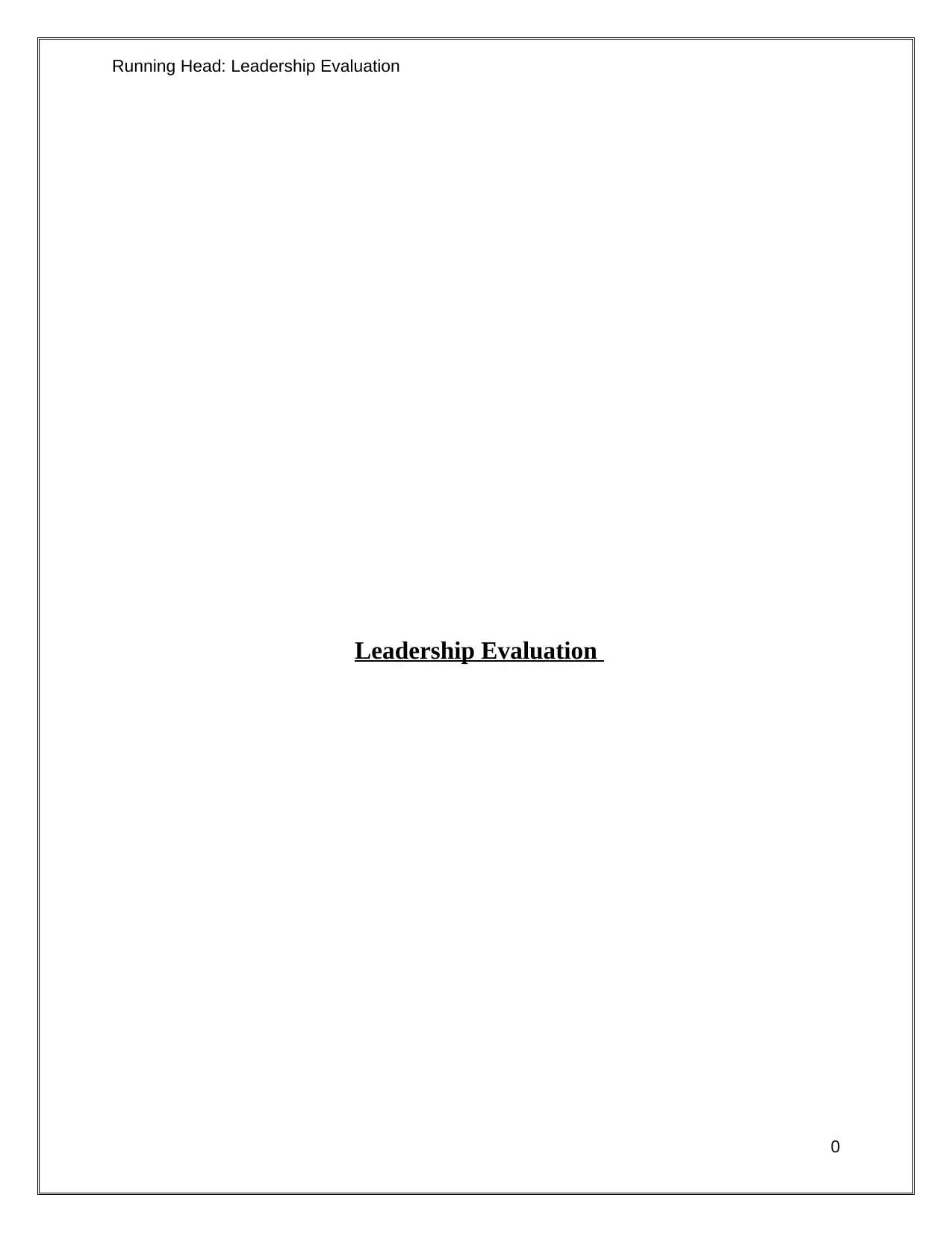
Running Head: Leadership Evaluation
Leadership Evaluation
0
Leadership Evaluation
0
Secure Best Marks with AI Grader
Need help grading? Try our AI Grader for instant feedback on your assignments.
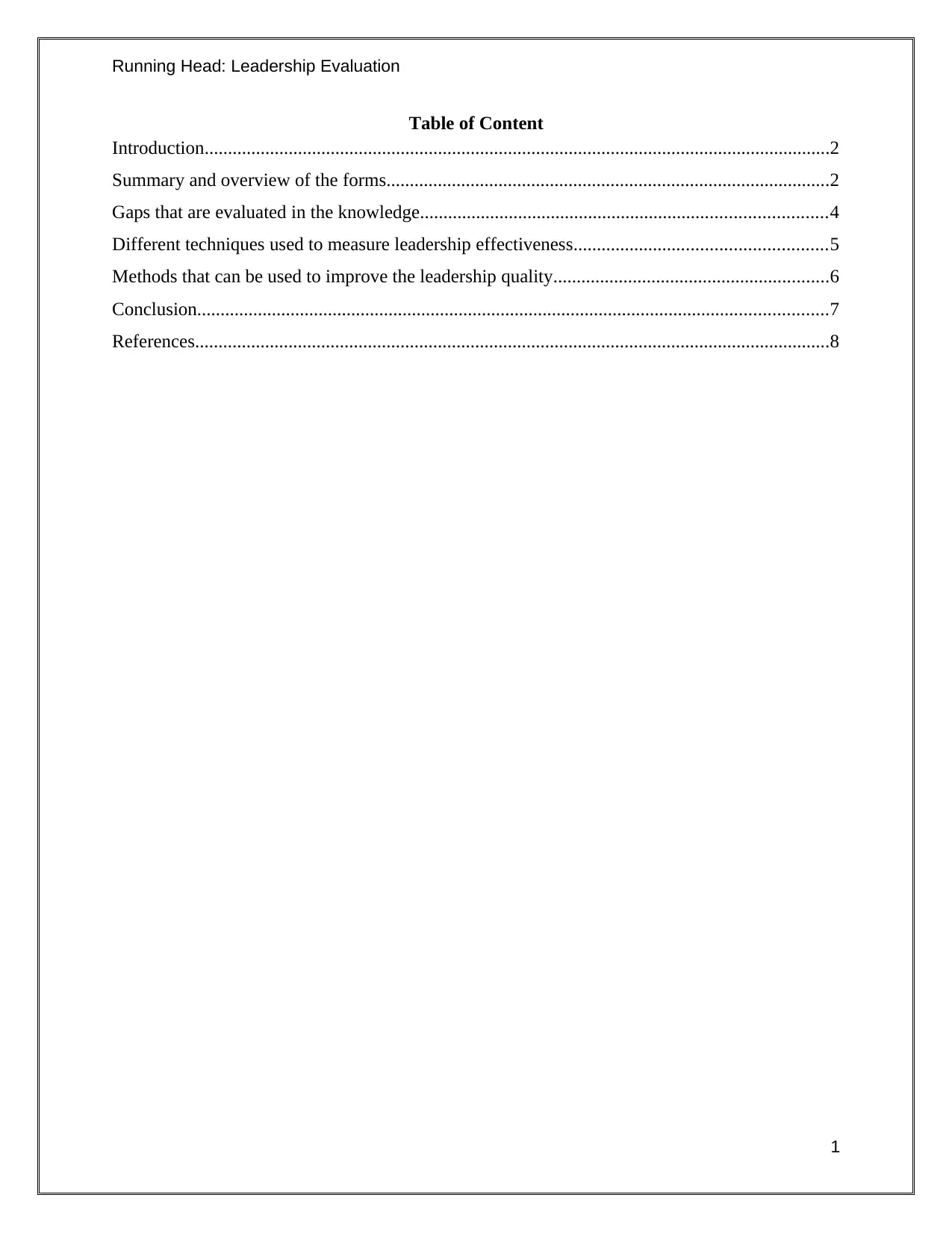
Running Head: Leadership Evaluation
Table of Content
Introduction......................................................................................................................................2
Summary and overview of the forms...............................................................................................2
Gaps that are evaluated in the knowledge.......................................................................................4
Different techniques used to measure leadership effectiveness......................................................5
Methods that can be used to improve the leadership quality...........................................................6
Conclusion.......................................................................................................................................7
References........................................................................................................................................8
1
Table of Content
Introduction......................................................................................................................................2
Summary and overview of the forms...............................................................................................2
Gaps that are evaluated in the knowledge.......................................................................................4
Different techniques used to measure leadership effectiveness......................................................5
Methods that can be used to improve the leadership quality...........................................................6
Conclusion.......................................................................................................................................7
References........................................................................................................................................8
1
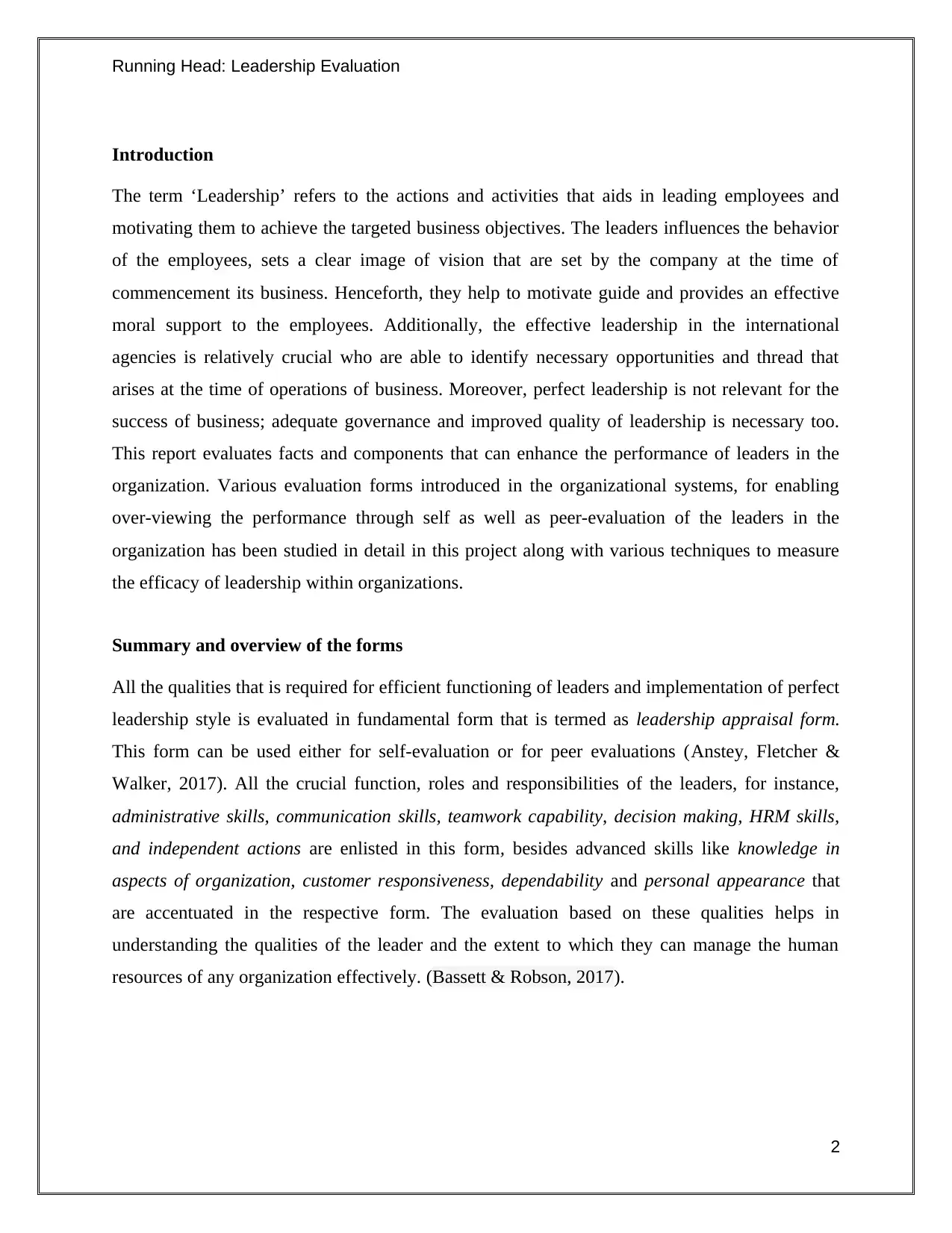
Running Head: Leadership Evaluation
Introduction
The term ‘Leadership’ refers to the actions and activities that aids in leading employees and
motivating them to achieve the targeted business objectives. The leaders influences the behavior
of the employees, sets a clear image of vision that are set by the company at the time of
commencement its business. Henceforth, they help to motivate guide and provides an effective
moral support to the employees. Additionally, the effective leadership in the international
agencies is relatively crucial who are able to identify necessary opportunities and thread that
arises at the time of operations of business. Moreover, perfect leadership is not relevant for the
success of business; adequate governance and improved quality of leadership is necessary too.
This report evaluates facts and components that can enhance the performance of leaders in the
organization. Various evaluation forms introduced in the organizational systems, for enabling
over-viewing the performance through self as well as peer-evaluation of the leaders in the
organization has been studied in detail in this project along with various techniques to measure
the efficacy of leadership within organizations.
Summary and overview of the forms
All the qualities that is required for efficient functioning of leaders and implementation of perfect
leadership style is evaluated in fundamental form that is termed as leadership appraisal form.
This form can be used either for self-evaluation or for peer evaluations (Anstey, Fletcher &
Walker, 2017). All the crucial function, roles and responsibilities of the leaders, for instance,
administrative skills, communication skills, teamwork capability, decision making, HRM skills,
and independent actions are enlisted in this form, besides advanced skills like knowledge in
aspects of organization, customer responsiveness, dependability and personal appearance that
are accentuated in the respective form. The evaluation based on these qualities helps in
understanding the qualities of the leader and the extent to which they can manage the human
resources of any organization effectively. (Bassett & Robson, 2017).
2
Introduction
The term ‘Leadership’ refers to the actions and activities that aids in leading employees and
motivating them to achieve the targeted business objectives. The leaders influences the behavior
of the employees, sets a clear image of vision that are set by the company at the time of
commencement its business. Henceforth, they help to motivate guide and provides an effective
moral support to the employees. Additionally, the effective leadership in the international
agencies is relatively crucial who are able to identify necessary opportunities and thread that
arises at the time of operations of business. Moreover, perfect leadership is not relevant for the
success of business; adequate governance and improved quality of leadership is necessary too.
This report evaluates facts and components that can enhance the performance of leaders in the
organization. Various evaluation forms introduced in the organizational systems, for enabling
over-viewing the performance through self as well as peer-evaluation of the leaders in the
organization has been studied in detail in this project along with various techniques to measure
the efficacy of leadership within organizations.
Summary and overview of the forms
All the qualities that is required for efficient functioning of leaders and implementation of perfect
leadership style is evaluated in fundamental form that is termed as leadership appraisal form.
This form can be used either for self-evaluation or for peer evaluations (Anstey, Fletcher &
Walker, 2017). All the crucial function, roles and responsibilities of the leaders, for instance,
administrative skills, communication skills, teamwork capability, decision making, HRM skills,
and independent actions are enlisted in this form, besides advanced skills like knowledge in
aspects of organization, customer responsiveness, dependability and personal appearance that
are accentuated in the respective form. The evaluation based on these qualities helps in
understanding the qualities of the leader and the extent to which they can manage the human
resources of any organization effectively. (Bassett & Robson, 2017).
2
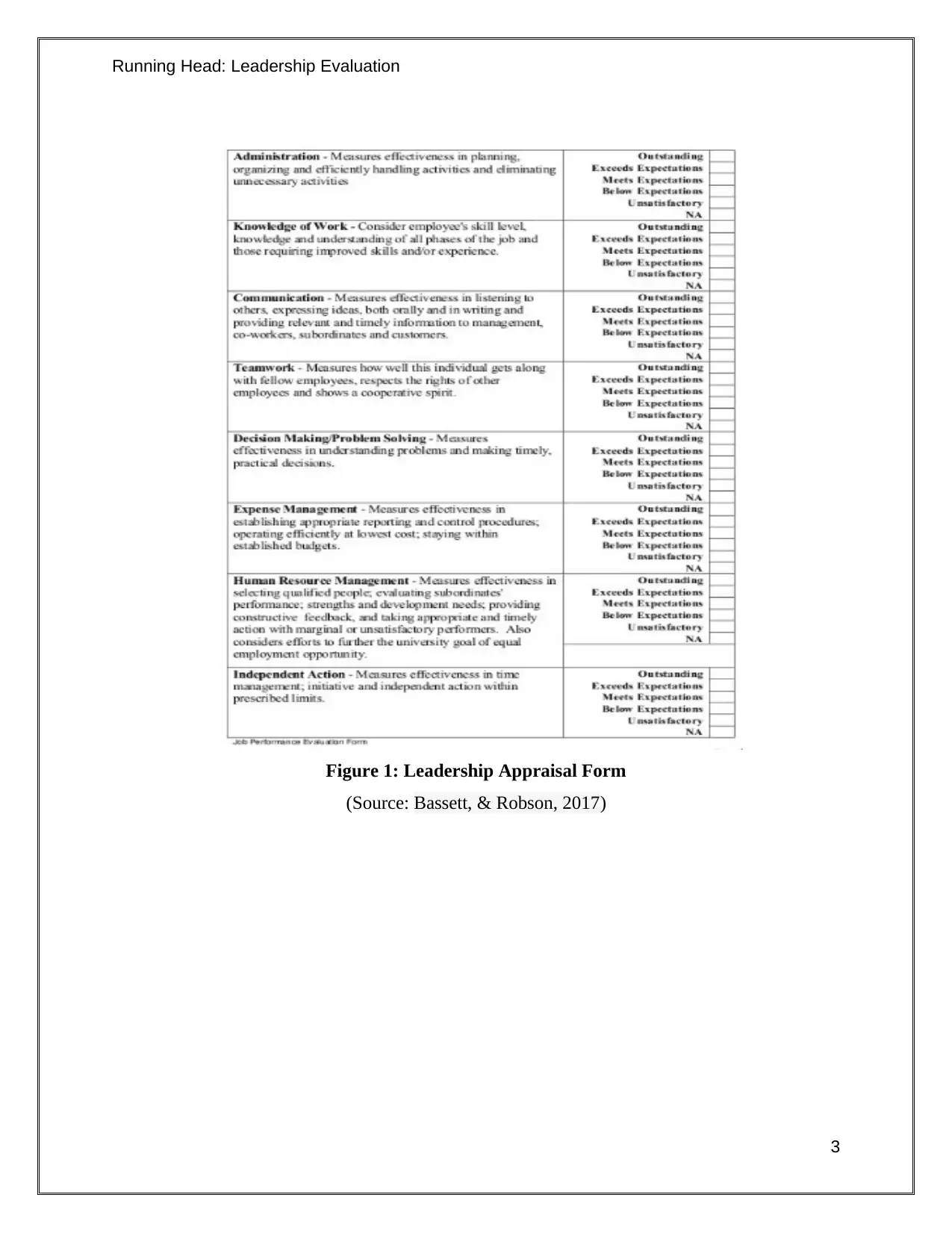
Running Head: Leadership Evaluation
Figure 1: Leadership Appraisal Form
(Source: Bassett, & Robson, 2017)
3
Figure 1: Leadership Appraisal Form
(Source: Bassett, & Robson, 2017)
3
Secure Best Marks with AI Grader
Need help grading? Try our AI Grader for instant feedback on your assignments.
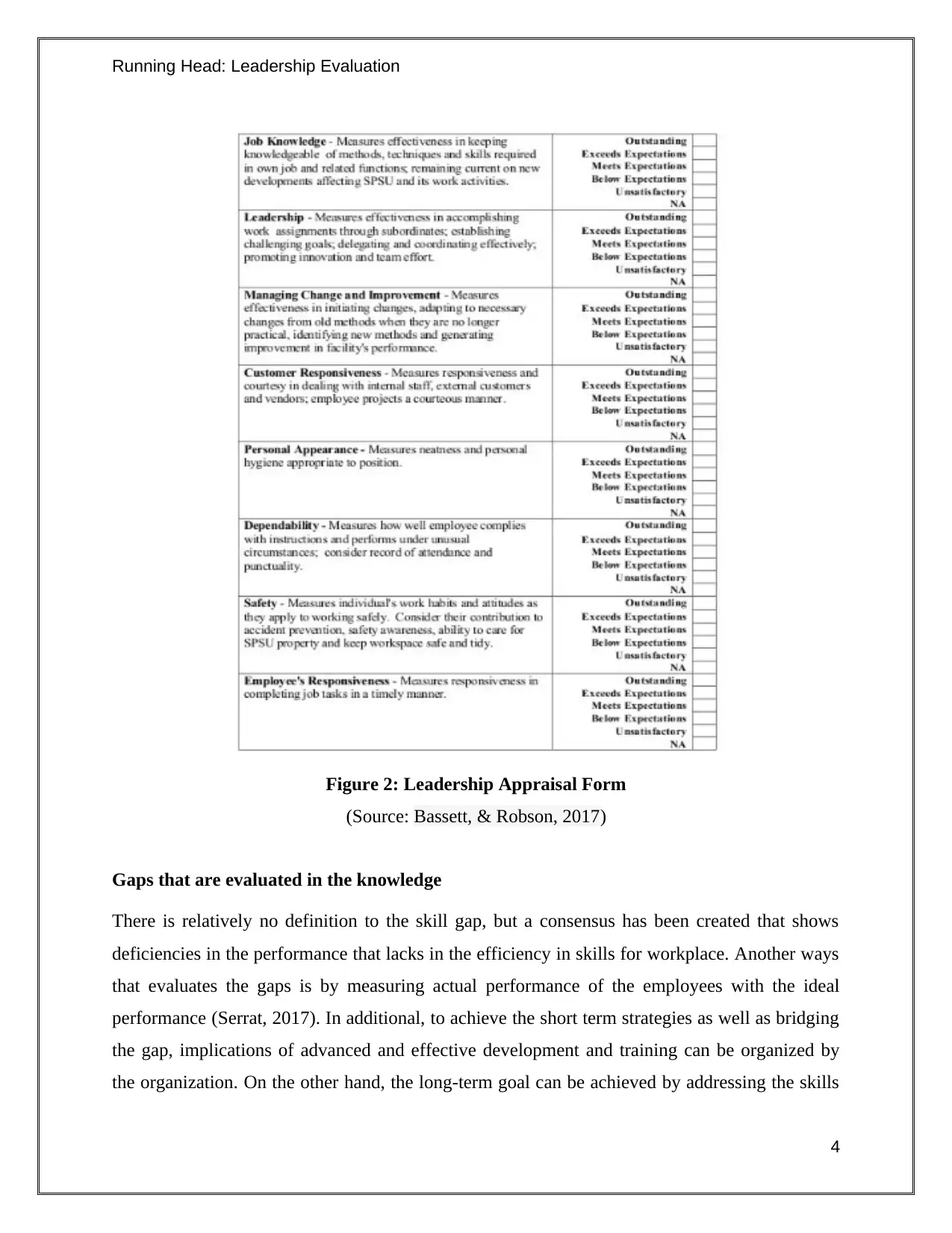
Running Head: Leadership Evaluation
Figure 2: Leadership Appraisal Form
(Source: Bassett, & Robson, 2017)
Gaps that are evaluated in the knowledge
There is relatively no definition to the skill gap, but a consensus has been created that shows
deficiencies in the performance that lacks in the efficiency in skills for workplace. Another ways
that evaluates the gaps is by measuring actual performance of the employees with the ideal
performance (Serrat, 2017). In additional, to achieve the short term strategies as well as bridging
the gap, implications of advanced and effective development and training can be organized by
the organization. On the other hand, the long-term goal can be achieved by addressing the skills
4
Figure 2: Leadership Appraisal Form
(Source: Bassett, & Robson, 2017)
Gaps that are evaluated in the knowledge
There is relatively no definition to the skill gap, but a consensus has been created that shows
deficiencies in the performance that lacks in the efficiency in skills for workplace. Another ways
that evaluates the gaps is by measuring actual performance of the employees with the ideal
performance (Serrat, 2017). In additional, to achieve the short term strategies as well as bridging
the gap, implications of advanced and effective development and training can be organized by
the organization. On the other hand, the long-term goal can be achieved by addressing the skills
4
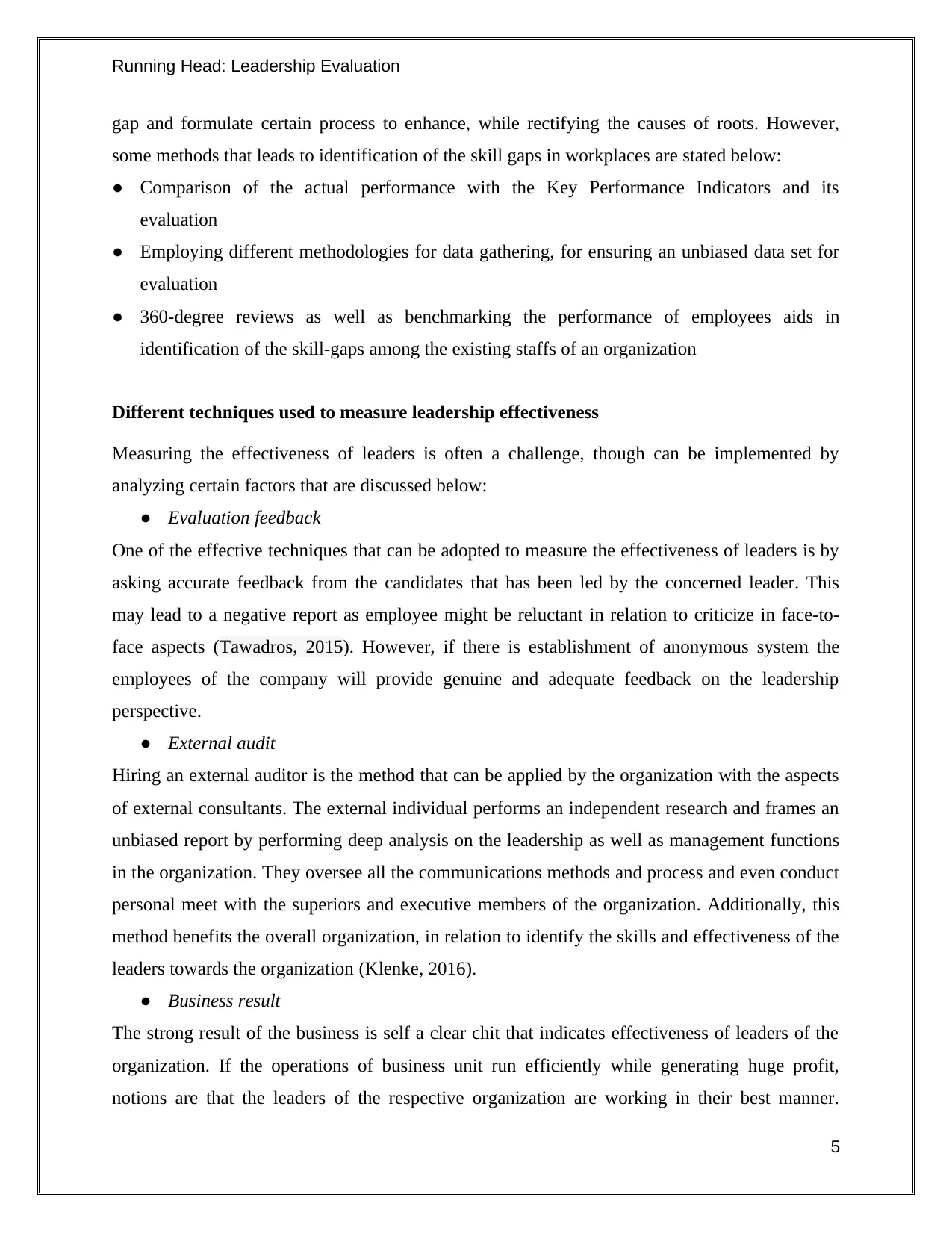
Running Head: Leadership Evaluation
gap and formulate certain process to enhance, while rectifying the causes of roots. However,
some methods that leads to identification of the skill gaps in workplaces are stated below:
● Comparison of the actual performance with the Key Performance Indicators and its
evaluation
● Employing different methodologies for data gathering, for ensuring an unbiased data set for
evaluation
● 360-degree reviews as well as benchmarking the performance of employees aids in
identification of the skill-gaps among the existing staffs of an organization
Different techniques used to measure leadership effectiveness
Measuring the effectiveness of leaders is often a challenge, though can be implemented by
analyzing certain factors that are discussed below:
● Evaluation feedback
One of the effective techniques that can be adopted to measure the effectiveness of leaders is by
asking accurate feedback from the candidates that has been led by the concerned leader. This
may lead to a negative report as employee might be reluctant in relation to criticize in face-to-
face aspects (Tawadros, 2015). However, if there is establishment of anonymous system the
employees of the company will provide genuine and adequate feedback on the leadership
perspective.
● External audit
Hiring an external auditor is the method that can be applied by the organization with the aspects
of external consultants. The external individual performs an independent research and frames an
unbiased report by performing deep analysis on the leadership as well as management functions
in the organization. They oversee all the communications methods and process and even conduct
personal meet with the superiors and executive members of the organization. Additionally, this
method benefits the overall organization, in relation to identify the skills and effectiveness of the
leaders towards the organization (Klenke, 2016).
● Business result
The strong result of the business is self a clear chit that indicates effectiveness of leaders of the
organization. If the operations of business unit run efficiently while generating huge profit,
notions are that the leaders of the respective organization are working in their best manner.
5
gap and formulate certain process to enhance, while rectifying the causes of roots. However,
some methods that leads to identification of the skill gaps in workplaces are stated below:
● Comparison of the actual performance with the Key Performance Indicators and its
evaluation
● Employing different methodologies for data gathering, for ensuring an unbiased data set for
evaluation
● 360-degree reviews as well as benchmarking the performance of employees aids in
identification of the skill-gaps among the existing staffs of an organization
Different techniques used to measure leadership effectiveness
Measuring the effectiveness of leaders is often a challenge, though can be implemented by
analyzing certain factors that are discussed below:
● Evaluation feedback
One of the effective techniques that can be adopted to measure the effectiveness of leaders is by
asking accurate feedback from the candidates that has been led by the concerned leader. This
may lead to a negative report as employee might be reluctant in relation to criticize in face-to-
face aspects (Tawadros, 2015). However, if there is establishment of anonymous system the
employees of the company will provide genuine and adequate feedback on the leadership
perspective.
● External audit
Hiring an external auditor is the method that can be applied by the organization with the aspects
of external consultants. The external individual performs an independent research and frames an
unbiased report by performing deep analysis on the leadership as well as management functions
in the organization. They oversee all the communications methods and process and even conduct
personal meet with the superiors and executive members of the organization. Additionally, this
method benefits the overall organization, in relation to identify the skills and effectiveness of the
leaders towards the organization (Klenke, 2016).
● Business result
The strong result of the business is self a clear chit that indicates effectiveness of leaders of the
organization. If the operations of business unit run efficiently while generating huge profit,
notions are that the leaders of the respective organization are working in their best manner.
5
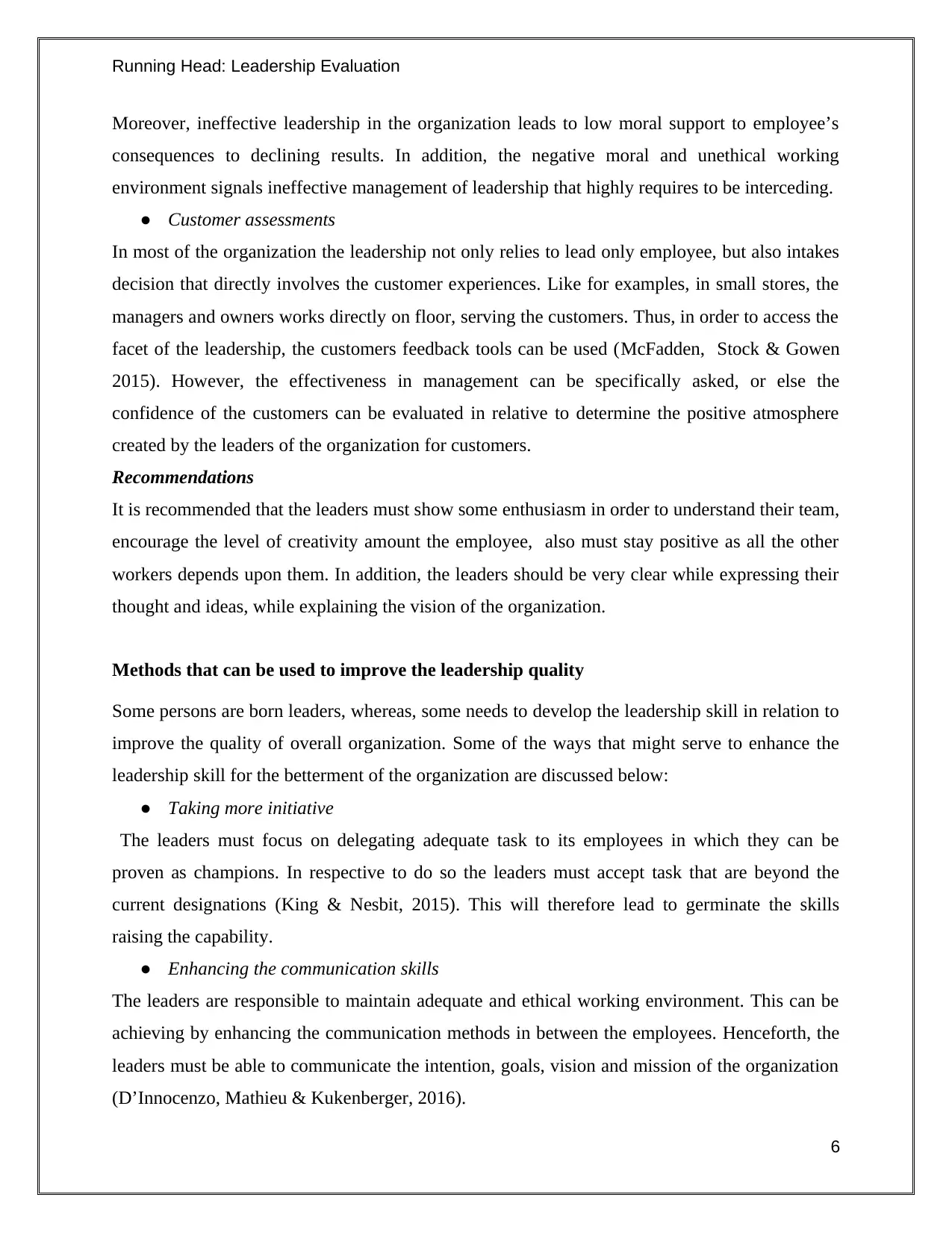
Running Head: Leadership Evaluation
Moreover, ineffective leadership in the organization leads to low moral support to employee’s
consequences to declining results. In addition, the negative moral and unethical working
environment signals ineffective management of leadership that highly requires to be interceding.
● Customer assessments
In most of the organization the leadership not only relies to lead only employee, but also intakes
decision that directly involves the customer experiences. Like for examples, in small stores, the
managers and owners works directly on floor, serving the customers. Thus, in order to access the
facet of the leadership, the customers feedback tools can be used (McFadden, Stock & Gowen
2015). However, the effectiveness in management can be specifically asked, or else the
confidence of the customers can be evaluated in relative to determine the positive atmosphere
created by the leaders of the organization for customers.
Recommendations
It is recommended that the leaders must show some enthusiasm in order to understand their team,
encourage the level of creativity amount the employee, also must stay positive as all the other
workers depends upon them. In addition, the leaders should be very clear while expressing their
thought and ideas, while explaining the vision of the organization.
Methods that can be used to improve the leadership quality
Some persons are born leaders, whereas, some needs to develop the leadership skill in relation to
improve the quality of overall organization. Some of the ways that might serve to enhance the
leadership skill for the betterment of the organization are discussed below:
● Taking more initiative
The leaders must focus on delegating adequate task to its employees in which they can be
proven as champions. In respective to do so the leaders must accept task that are beyond the
current designations (King & Nesbit, 2015). This will therefore lead to germinate the skills
raising the capability.
● Enhancing the communication skills
The leaders are responsible to maintain adequate and ethical working environment. This can be
achieving by enhancing the communication methods in between the employees. Henceforth, the
leaders must be able to communicate the intention, goals, vision and mission of the organization
(D’Innocenzo, Mathieu & Kukenberger, 2016).
6
Moreover, ineffective leadership in the organization leads to low moral support to employee’s
consequences to declining results. In addition, the negative moral and unethical working
environment signals ineffective management of leadership that highly requires to be interceding.
● Customer assessments
In most of the organization the leadership not only relies to lead only employee, but also intakes
decision that directly involves the customer experiences. Like for examples, in small stores, the
managers and owners works directly on floor, serving the customers. Thus, in order to access the
facet of the leadership, the customers feedback tools can be used (McFadden, Stock & Gowen
2015). However, the effectiveness in management can be specifically asked, or else the
confidence of the customers can be evaluated in relative to determine the positive atmosphere
created by the leaders of the organization for customers.
Recommendations
It is recommended that the leaders must show some enthusiasm in order to understand their team,
encourage the level of creativity amount the employee, also must stay positive as all the other
workers depends upon them. In addition, the leaders should be very clear while expressing their
thought and ideas, while explaining the vision of the organization.
Methods that can be used to improve the leadership quality
Some persons are born leaders, whereas, some needs to develop the leadership skill in relation to
improve the quality of overall organization. Some of the ways that might serve to enhance the
leadership skill for the betterment of the organization are discussed below:
● Taking more initiative
The leaders must focus on delegating adequate task to its employees in which they can be
proven as champions. In respective to do so the leaders must accept task that are beyond the
current designations (King & Nesbit, 2015). This will therefore lead to germinate the skills
raising the capability.
● Enhancing the communication skills
The leaders are responsible to maintain adequate and ethical working environment. This can be
achieving by enhancing the communication methods in between the employees. Henceforth, the
leaders must be able to communicate the intention, goals, vision and mission of the organization
(D’Innocenzo, Mathieu & Kukenberger, 2016).
6
Paraphrase This Document
Need a fresh take? Get an instant paraphrase of this document with our AI Paraphraser
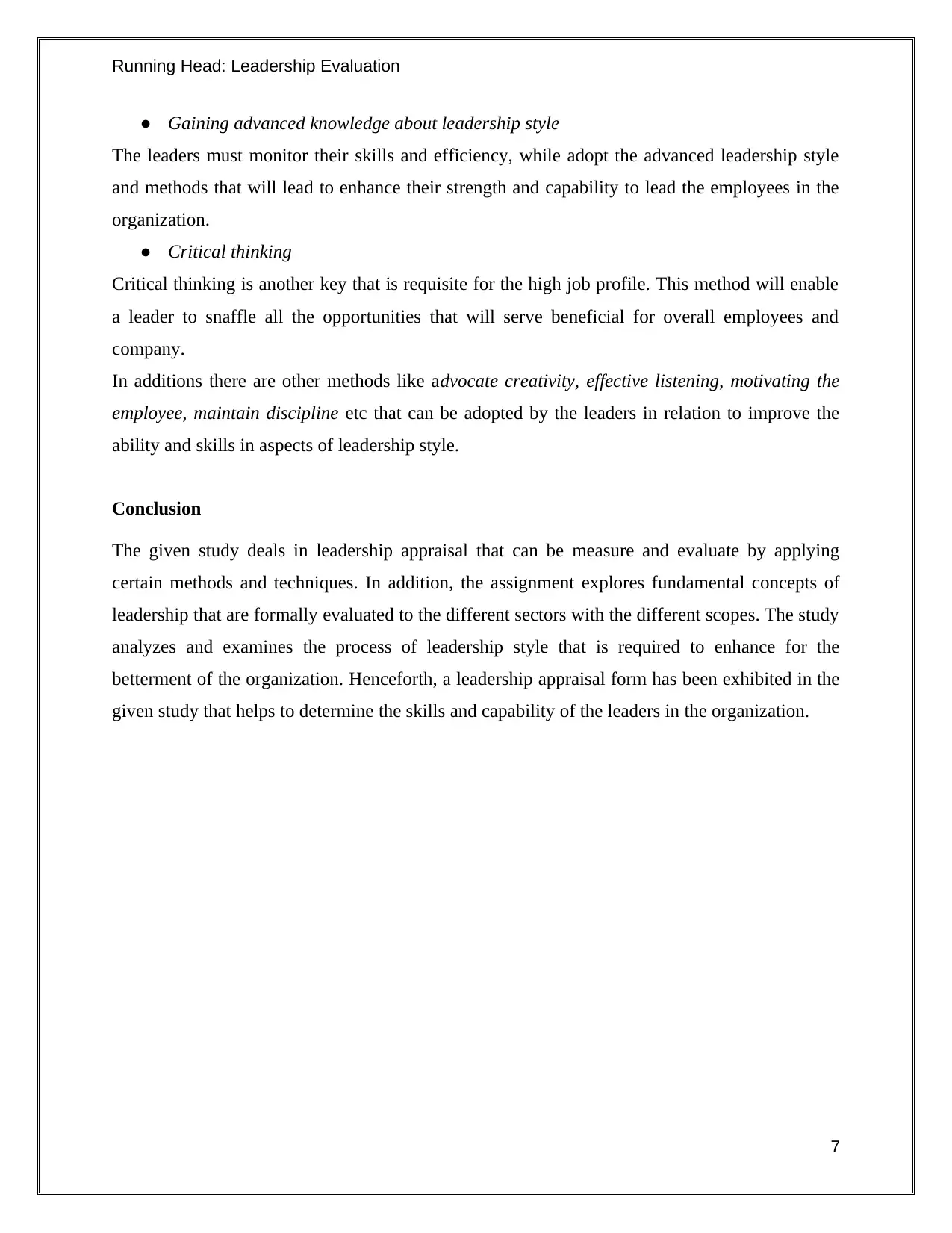
Running Head: Leadership Evaluation
● Gaining advanced knowledge about leadership style
The leaders must monitor their skills and efficiency, while adopt the advanced leadership style
and methods that will lead to enhance their strength and capability to lead the employees in the
organization.
● Critical thinking
Critical thinking is another key that is requisite for the high job profile. This method will enable
a leader to snaffle all the opportunities that will serve beneficial for overall employees and
company.
In additions there are other methods like advocate creativity, effective listening, motivating the
employee, maintain discipline etc that can be adopted by the leaders in relation to improve the
ability and skills in aspects of leadership style.
Conclusion
The given study deals in leadership appraisal that can be measure and evaluate by applying
certain methods and techniques. In addition, the assignment explores fundamental concepts of
leadership that are formally evaluated to the different sectors with the different scopes. The study
analyzes and examines the process of leadership style that is required to enhance for the
betterment of the organization. Henceforth, a leadership appraisal form has been exhibited in the
given study that helps to determine the skills and capability of the leaders in the organization.
7
● Gaining advanced knowledge about leadership style
The leaders must monitor their skills and efficiency, while adopt the advanced leadership style
and methods that will lead to enhance their strength and capability to lead the employees in the
organization.
● Critical thinking
Critical thinking is another key that is requisite for the high job profile. This method will enable
a leader to snaffle all the opportunities that will serve beneficial for overall employees and
company.
In additions there are other methods like advocate creativity, effective listening, motivating the
employee, maintain discipline etc that can be adopted by the leaders in relation to improve the
ability and skills in aspects of leadership style.
Conclusion
The given study deals in leadership appraisal that can be measure and evaluate by applying
certain methods and techniques. In addition, the assignment explores fundamental concepts of
leadership that are formally evaluated to the different sectors with the different scopes. The study
analyzes and examines the process of leadership style that is required to enhance for the
betterment of the organization. Henceforth, a leadership appraisal form has been exhibited in the
given study that helps to determine the skills and capability of the leaders in the organization.
7
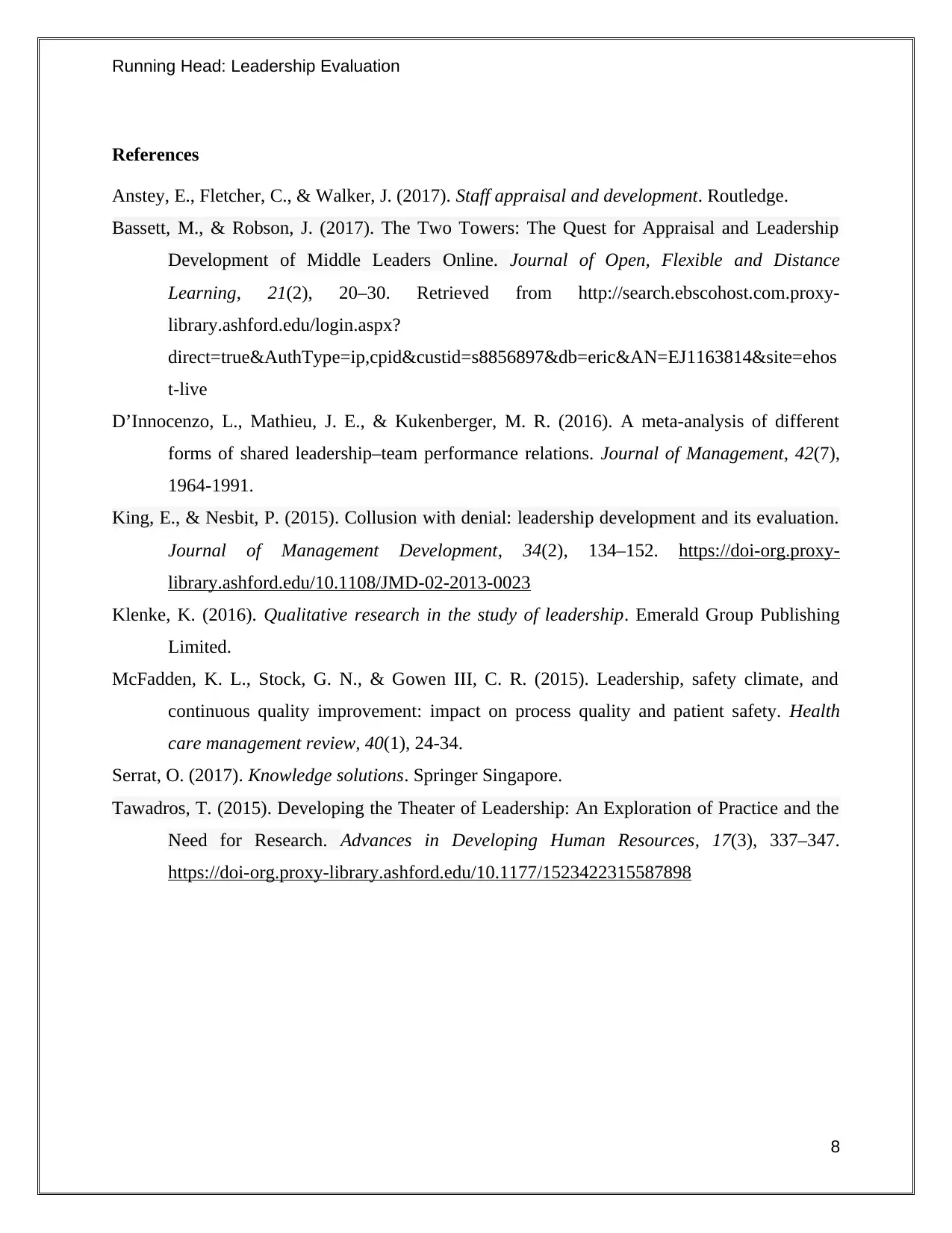
Running Head: Leadership Evaluation
References
Anstey, E., Fletcher, C., & Walker, J. (2017). Staff appraisal and development. Routledge.
Bassett, M., & Robson, J. (2017). The Two Towers: The Quest for Appraisal and Leadership
Development of Middle Leaders Online. Journal of Open, Flexible and Distance
Learning, 21(2), 20–30. Retrieved from http://search.ebscohost.com.proxy-
library.ashford.edu/login.aspx?
direct=true&AuthType=ip,cpid&custid=s8856897&db=eric&AN=EJ1163814&site=ehos
t-live
D’Innocenzo, L., Mathieu, J. E., & Kukenberger, M. R. (2016). A meta-analysis of different
forms of shared leadership–team performance relations. Journal of Management, 42(7),
1964-1991.
King, E., & Nesbit, P. (2015). Collusion with denial: leadership development and its evaluation.
Journal of Management Development, 34(2), 134–152. https://doi-org.proxy-
library.ashford.edu/10.1108/JMD-02-2013-0023
Klenke, K. (2016). Qualitative research in the study of leadership. Emerald Group Publishing
Limited.
McFadden, K. L., Stock, G. N., & Gowen III, C. R. (2015). Leadership, safety climate, and
continuous quality improvement: impact on process quality and patient safety. Health
care management review, 40(1), 24-34.
Serrat, O. (2017). Knowledge solutions. Springer Singapore.
Tawadros, T. (2015). Developing the Theater of Leadership: An Exploration of Practice and the
Need for Research. Advances in Developing Human Resources, 17(3), 337–347.
https://doi-org.proxy-library.ashford.edu/10.1177/1523422315587898
8
References
Anstey, E., Fletcher, C., & Walker, J. (2017). Staff appraisal and development. Routledge.
Bassett, M., & Robson, J. (2017). The Two Towers: The Quest for Appraisal and Leadership
Development of Middle Leaders Online. Journal of Open, Flexible and Distance
Learning, 21(2), 20–30. Retrieved from http://search.ebscohost.com.proxy-
library.ashford.edu/login.aspx?
direct=true&AuthType=ip,cpid&custid=s8856897&db=eric&AN=EJ1163814&site=ehos
t-live
D’Innocenzo, L., Mathieu, J. E., & Kukenberger, M. R. (2016). A meta-analysis of different
forms of shared leadership–team performance relations. Journal of Management, 42(7),
1964-1991.
King, E., & Nesbit, P. (2015). Collusion with denial: leadership development and its evaluation.
Journal of Management Development, 34(2), 134–152. https://doi-org.proxy-
library.ashford.edu/10.1108/JMD-02-2013-0023
Klenke, K. (2016). Qualitative research in the study of leadership. Emerald Group Publishing
Limited.
McFadden, K. L., Stock, G. N., & Gowen III, C. R. (2015). Leadership, safety climate, and
continuous quality improvement: impact on process quality and patient safety. Health
care management review, 40(1), 24-34.
Serrat, O. (2017). Knowledge solutions. Springer Singapore.
Tawadros, T. (2015). Developing the Theater of Leadership: An Exploration of Practice and the
Need for Research. Advances in Developing Human Resources, 17(3), 337–347.
https://doi-org.proxy-library.ashford.edu/10.1177/1523422315587898
8
1 out of 9
Related Documents
Your All-in-One AI-Powered Toolkit for Academic Success.
+13062052269
info@desklib.com
Available 24*7 on WhatsApp / Email
![[object Object]](/_next/static/media/star-bottom.7253800d.svg)
Unlock your academic potential
© 2024 | Zucol Services PVT LTD | All rights reserved.





